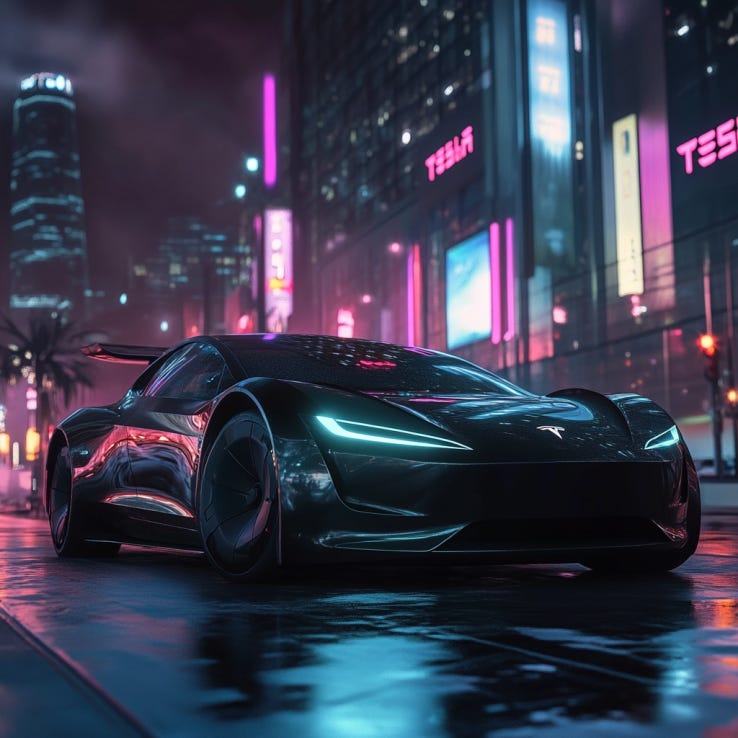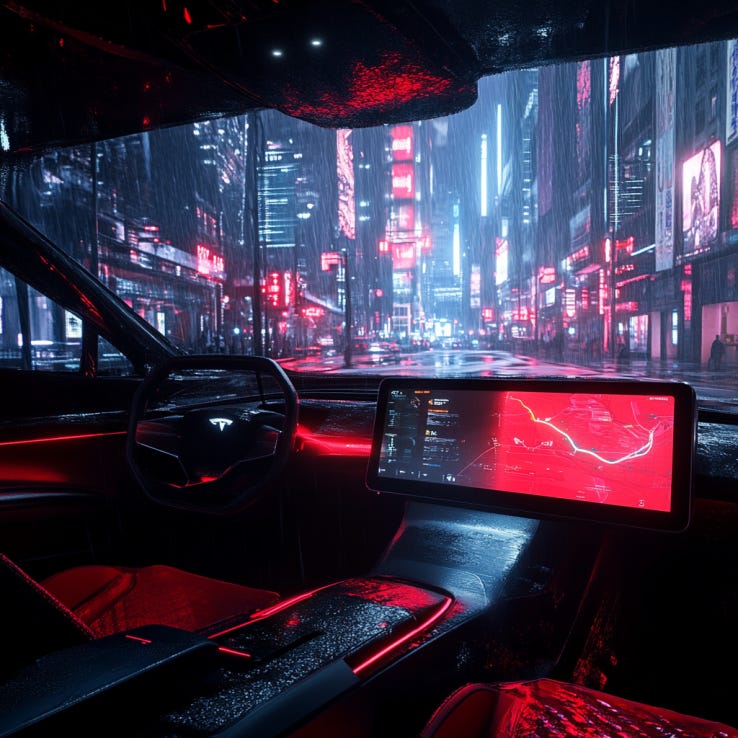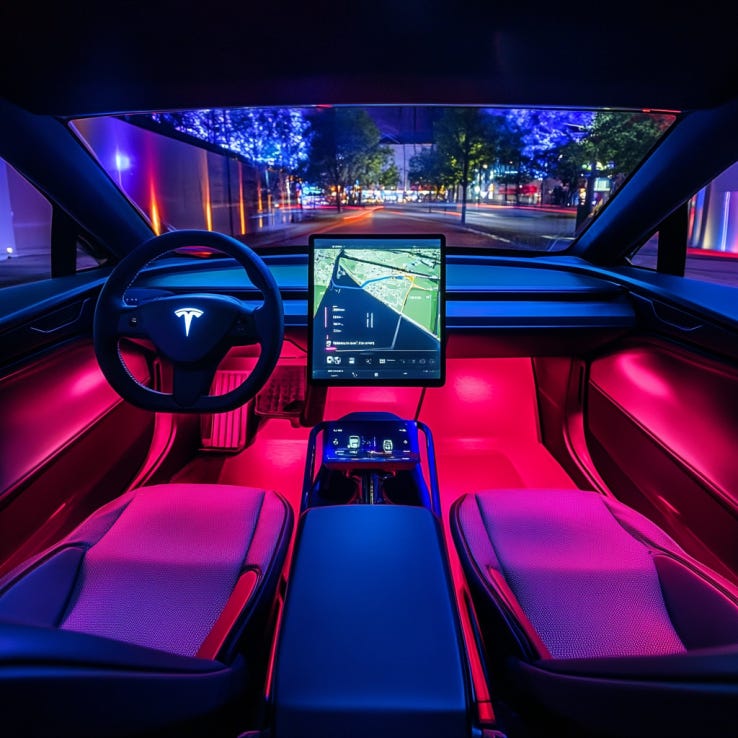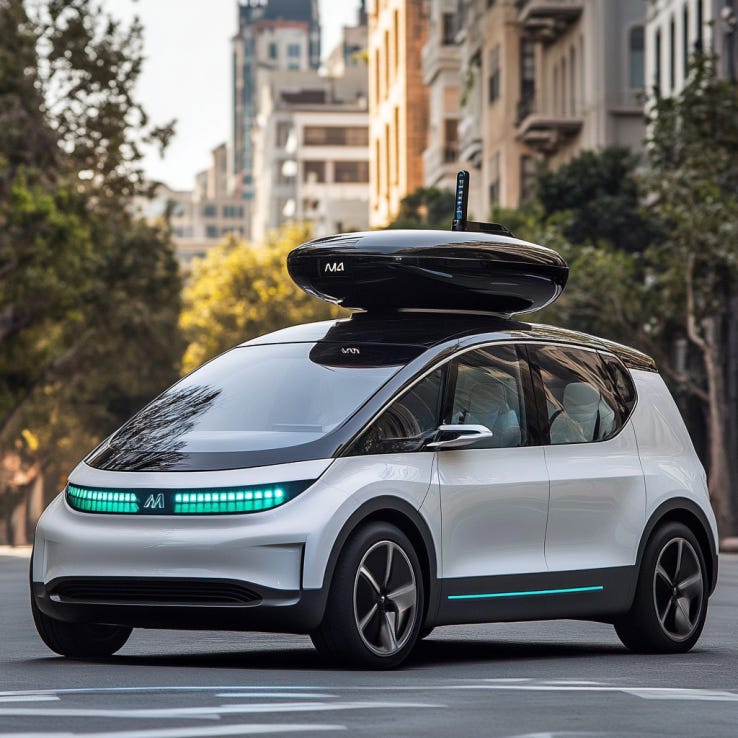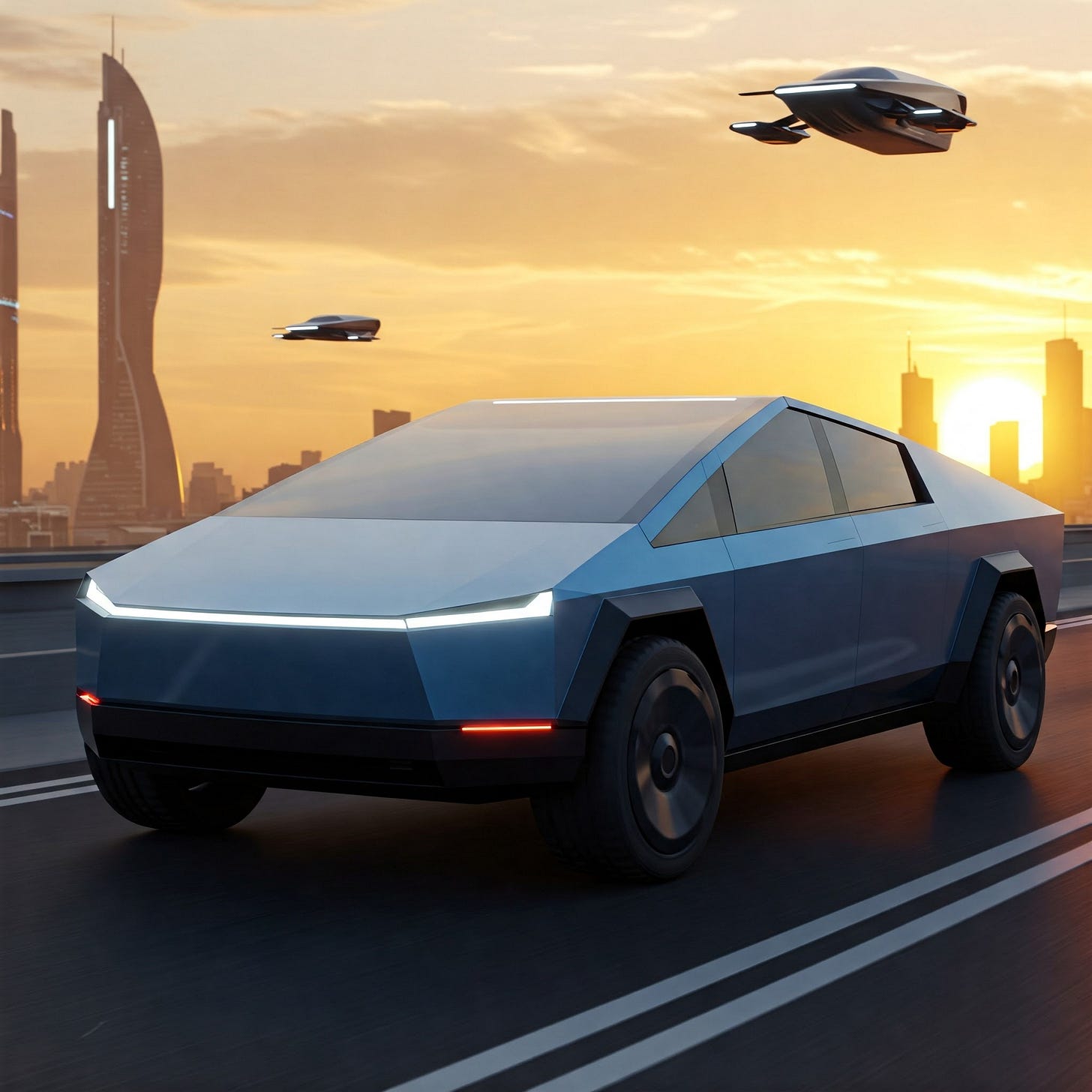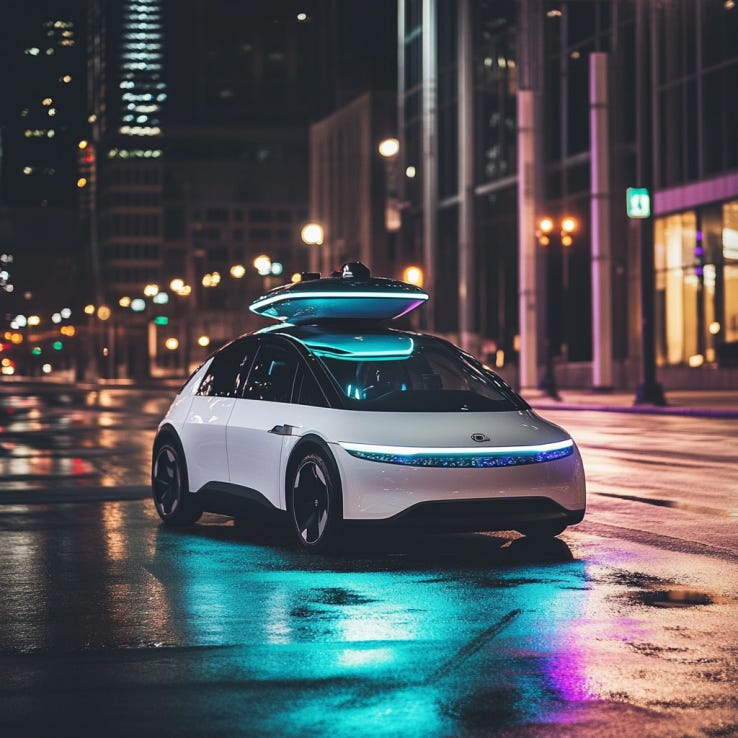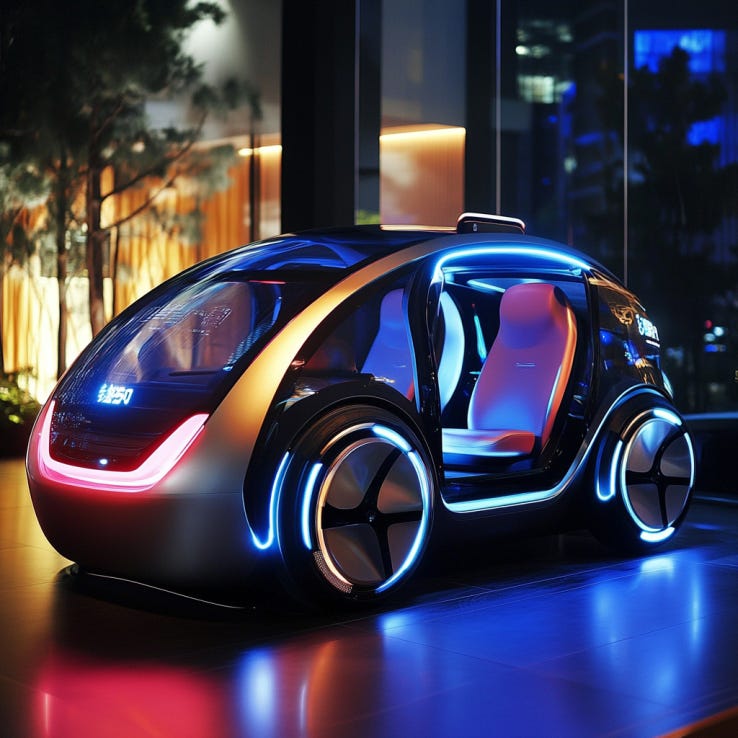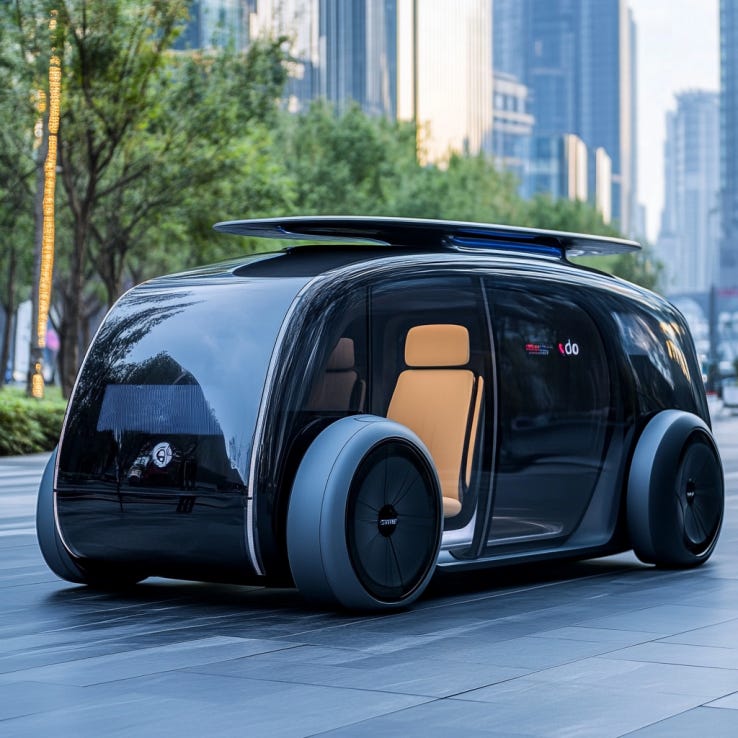Autonomous Vehicles Research: Who's Winning the Robotaxi Race to L5 FSD? (Top AV Investments 2025-2035)
The 2025 competition? Waymo & Tesla in the U.S. & Baidu in China
For a while I’ve intended to research and analyze the 2025 autonomous vehicle (AV) landscape within the U.S. and globally… and I finally got around to it.
My goal was to determine who is currently “winning” the AV race toward mainstream (i.e. ubiquitous) Level 4 FSD robotaxi rollouts and who will be first to achieve the “holy grail” Level 5 autonomy — as well as be first to roll this out en masse (across an entire country).
I focused mostly on the strongest AV companies and evaluated AV strategies (radar, lidar, cameras, etc.), safety data (disengagement rates), and considered a few OEM (picks-and-shovels) providers.
Considering everything from a macro/holistic perspective, I provided a forecast for companies that I think are poised to generate the best risk-adjusted returns for investors with an AV-specific focus from 2025-2035.
Note: Smaller companies were mostly ignored… some could “boom” in coming years, but they aren’t serious contenders at this point. In the U.S. the competition is mostly just Waymo and Tesla. In China Baidu is leading the pack.
Autonomous Vehicles (AVs) in 2025: Robotaxi & FSD Market Status
Full Self-Driving (FSD) technology has rapidly evolved, moving beyond limited driver-assistance to near-fully autonomous operation in certain locales. By 2025:
Waymo operates driverless robotaxis (no safety driver) in multiple American cities (Phoenix, San Francisco, L.A., Austin, ATL). Currently testing in Vegas, San Diego, and plan to expand to Miami and Tokyo.
Tesla partially reversed its “vision-only” stance, reintroducing radar in certain new vehicles to bolster edge-case performance, yet the system still relies primarily on camera-based neural networks. They plan to initiate robotaxi testing in Austin in H2 2025.
Baidu is accelerating China’s largest robotaxi rollout, though barred from the U.S. market due to regulatory restrictions. Was formerly tested in California cities in 2016 and 2021 — but no longer operates in the U.S.
Recent AV Industry Shifts (2025)
GM & Cruise Pivot
Cruise’s standalone robotaxi approach ended in late 2024, merging into GM’s internal ADAS programs (Super Cruise/Ultra Cruise).
Leaves Waymo (and possibly Tesla) as major large-scale U.S. robotaxi operators.
Chinese AV Ban in U.S.
Baidu, Pony.ai, WeRide, etc. cannot offer commercial services on American roads, creating a two-track global market: the U.S. side (Waymo, Tesla) vs. Chinese side (Baidu, Pony, etc.).
Tesla’s Radar Reintroduction
After a “vision-only” period (2021–2022), Tesla added a new “Phoenix” 76–77 GHz radar in 2024 on Model S/X (HW4).
Model 3/Y remain camera-centric. Elon Musk states any radar use must justify itself with “radar-only braking.”
LiDAR Cost Declines
LiDAR was once tens of thousands of dollars per unit. By 2025, many units cost below $1k (some aiming for $500 by 2027), enabling multi-sensor fleets (Waymo, Baidu) to scale more affordably.
AV Market Landscape & TAM: 2025-2035
1. Global Autonomous Prospects
By the early 2030s, analysts project a $500B–$1T total addressable market (TAM) for autonomous vehicles globally, encompassing:
Robotaxi Services (both in the U.S. and China, plus expansions in select European or Middle Eastern cities).
Personal L4/L5 Vehicles sold to consumers with advanced autonomy capabilities.
Autonomous Logistics (delivery, trucking) also contributes a significant share.
The U.S. and China lead this space, with Europe trailing due to fragmented regulatory environments.
In the U.S., regulatory patchworks and NHTSA investigations shape the pace of city deployments. In China, Baidu enjoys robust local support and minimal foreign competition.
2. U.S. Market Focus
Robotaxi (Ride-Hailing) TAM: Estimated at $150B–$300B by ~2030-2035.
Waymo is the frontrunner, actively deploying no-safety-driver service in multiple cities.
Tesla aspires to create a “Tesla Network” if it achieves unsupervised city-level FSD.
Consumer FSD Software: $50B–$60B potential by 2030 for advanced ADAS, with Tesla as the main example (FSD add-on or subscription).
Regulatory Patchwork:
California DMV demands official disengagement reporting for AV testers, which Waymo and Baidu have submitted in prior years. Tesla does not (under the L2 classification).
NHTSA actively scrutinizes Tesla’s FSD safety claims.
3. China’s Parallel Market
Baidu (Apollo): Expanding robotaxis in Beijing, Shanghai, Wuhan, and other major cities, serving millions of rides with minimal publicly reported accidents or major disengagements.
Local Competition: Pony.ai, AutoX, BYD’s DiPilot, WeRide, Didi Chuxing, etc. are trying to catch Baidu… Currently Baidu is crushing the competition.
Banned from U.S.: Chinese AV operators remain locked out of American roads due to security/data concerns.
Three Major AV & FSD Companies (2025 Overview)
1.) Tesla
Market Cap: ~$1.25T (Feb 2025).
Sensor Strategy: Vision + partial radar (HW4 S/X). Model 3/Y still camera-only.
FSD Program: Beta remains L2 with driver supervision; city interventions remain frequent.
Challenges:
HW3 → HW4 retrofits hamper near-term scale.
NHTSA investigating potential misleading claims.
Tesla’s data is largely user-sourced, with no official 3rd-party audit verifying city-level FSD interventions, raising concerns about potential biases or inflated claims.
Potential: If Tesla solves unsupervised city FSD, it could “flip the switch” overnight across millions of cars, capturing a massive chunk of the U.S. ride-hailing market.
2.) Waymo (Alphabet)
Market Cap (Alphabet): ~$2.49T (Feb 2025).
Multi-Sensor: LiDAR, radar, cameras, plus detailed HD maps. (LiDAR remains the gold standard for Level 4 AVs in 2025)
Deployment: Fully driverless robotaxis (no safety driver) in Phoenix, SF, LA expansions. CA DMV data shows ~17k miles between disengagements, among the best.
Licensing: Waymo has indicated interest in licensing “Waymo Driver” to OEMs, but so far only small-scale collaborations. If widely adopted, it could expand revenue beyond direct robotaxi ops.
Strength: Low-disengagement L4 in multiple cities. Steady city-by-city approach, capital-intensive but proven safe.
3.) Baidu (Apollo)
Market Cap: ~$31.1B (Feb 2025).
China-Focused: Aims for 65+ Chinese cities by 2025, serving millions of rides. Robotaxi cost: $28k per vehicle.
No U.S. presence but can license Apollo’s tech to local OEMs, further monetizing.
Progress: 2019 CA test data showed ~18k miles per disengagement; now focuses on Chinese expansions. Freed from foreign competition, with strong government support.
Other Players
NVIDIA: The AI Accelerator
Provides foundational hardware and software for autonomous vehicles through the NVIDIA DRIVE platform. Invested ~$7B in 2025 just on AV R&D.
DRIVE Orin/Thor SoCs – High-performance AI processors (254-2000 TOPS) powering perception and path planning.
End-to-End Stack – Includes Omniverse simulation and sensor fusion algorithms.
Partnerships – Works with Toyota (ADAS), Aurora (robotaxis), and Uber (AI training).
Robotaxi Potential:
Strength: NVIDIA dominates the compute platform market, with 75% of Chinese Level 4 players using its hardware.
Limitation: Does not operate fleets directly; its success depends on the execution of its partners.
Outlook: Expected to power ~40-50% of robotaxi fleets by 2030 through partnerships with OEMs and startups but faces margin pressure from Chinese chipmakers.
Mobileye: The Incremental Innovator
Transitioning from ADAS to full autonomy through EyeQ chips and REM mapping. Invested $1.5B on AV R&D for 2025.
EyeQ6/Ultra SoCs – High-efficiency AI chips with dedicated accelerators for perception.
True Redundancy – Combines camera, radar, and lidar for late sensor fusion.
OEM Network – Technology deployed in over 800 models across 50 automakers.
Robotaxi Potential:
Strength: Mobileye has access to 250 petabytes of training data and a production-ready Chauffeur system.
Limitation: Initial focus is on Level 2 and Level 3 autonomy, delaying full robotaxi deployment (Drive) to 2026 or later.
Outlook: Likely to capture ~20-30% of OEM robotaxi programs but will struggle to compete with full-stack operators like Waymo in scalability.
Challenges to Achieving Full Self-Driving (FSD)
Sensor Limitations & Cost
LiDAR historically expensive, now dropping below $1k—favorable for Waymo/Baidu’s multi-sensor approach.
Tesla partial radar reintroduction suggests purely vision-based solution faced trouble in poor visibility or edge cases.
Urban Complexity
Handling unprotected left turns, pedestrians, cyclists, random merges, inconsistent signage.
Waymo has a “zone mastery” approach (mapping + sensor fusion), Tesla tries generalized AI across many conditions.
Edge Cases & Ethical Dilemmas
Road debris, odd intersections, ethical priorities (who to protect in a potential crash).
Slow but necessary corner-case training for L4/L5.
Regulatory & Liability
NHTSA investigating Tesla’s FSD marketing and crash incidents.
States like California, Arizona, Texas vary on how quickly they allow driverless operations.
China fosters Baidu expansions, but minimal foreign competition.
Safety & Disengagement Data Analysis: 2025
As of 2025, Tesla is the only major FSD contender that hasn’t been subject to extensive third-party audits/testing from state-level DMVs and NHTSA.
Tesla has presented a lot of reports showing how safe Tesla’s FSD technology is and/or how well it’s progressing, however, these reports are based on low-quality data (heavily biased from high-profile Tesla owners, specific routes/locations).
READ: Tesla Full Self-Driving 2025 Progress
California DMV Reports
Waymo: ~3.67M miles in 2023, ~212 disengagements → ~17k mi/disengagement. Historically improved from ~13k in 2019, ~11k in 2018.
Baidu: Minimal 2023 CA test (578 miles, no reported disengagements). Historically showed ~18k miles/disengagement in 2019 tests.
Tesla: Not in CA autonomous program; no official DMV stats. They continue to classify FSD as Level 2 ADAS, exempt from these reports.
Company-Reported & Independent Data
Waymo: Achieves real driverless service in Phoenix, SF with minimal critical events. Unofficial data suggests ~10k–17k mi/disengagement.
Baidu: In China, no publicly available “disengagement” metrics like the CA DMV. But ~7 million cumulative rides, no major crashes reported.
Tesla:
City Driving (FSD Beta): Some trackers show an intervention every ~13–72 miles. Contrasting claims from certain bullish analysts/TSLA investors put it near ~15k miles, but lacking official transparency.
Highway (Autopilot): ~1 crash per 7.6M miles (company data), signifying strong performance in structured highways.
Operational Context
Waymo and Baidu target geofenced, heavily mapped areas, typically with fewer unplanned variables.
Tesla aims for a broader but still L2 approach, reliant on massive user data for improvements.
Weather & Complexity: Testing expansions to dense cities (e.g., SF, Beijing) can initially raise intervention frequency.
Key Observations
Waymo leads in official reliability, consistently ~10k–17k miles per intervention in CA testing, plus real driverless ops.
Baidu has strong domestic results, minimal U.S. presence.
Tesla remains behind in city-level unsupervised metrics, but its camera + partial radar approach might catch up if neural nets solve enough corner cases.
Rate of Robotaxi Rollout & Progress (2025)
1.) Tesla
Consumer Fleet & OTA:
Over 4 million vehicles with HW3, a portion now upgrading to HW4 (Model S/X) featuring partial radar.
Over-the-air updates can quickly propagate FSD improvements to existing owners if/when unsupervised L4 is solved.
Retrofit Complexity:
HW3 → HW4 retrofits for owners who purchased FSD are time-consuming and costly.
Could slow short-term deployment of a true L4 “robotaxi mode.”
2025 Status:
FSD Beta remains L2, requiring driver oversight. Disengagement data from third parties suggests frequent interventions (one every 13–72 miles in city driving).
Tesla claims a potential major leap with FSD v13 or v14, but timelines remain speculative.
2.) Waymo (Alphabet)
City-by-City Robotaxi:
Expanding fully driverless rides (no safety driver) from Phoenix suburbs to San Francisco; launching in Los Angeles.
High upfront costs (LiDAR-equipped vehicles, extensive mapping, safety validation).
Demonstrated Reliability:
~10k–17k miles per disengagement in California testing, plus robust real-world driverless operations (with no safety driver).
Expansion Trajectory:
Targets 5–10 major U.S. metros by 2027–2028. Each city rollout is capital-intensive but yields consistent safety performance.
3.) Baidu (Apollo)
China’s Leading Robotaxi:
Over 7 million cumulative rides, focusing on cost-efficient hardware ($28k per vehicle) to achieve profitability by mid-decade.
Freed from foreign AV competition in China, but banned in the U.S.
Progress:
Cities like Beijing, Wuhan, Shanghai see expansions, with Baidu obtaining fully driverless (no safety driver) permits in select zones.
Aims for coverage in 65+ Chinese cities by 2025, 100 by 2030.
4.) Smaller Competitors
Zoox (Amazon-backed): Custom-designed bidirectional robotaxis. Initially testing in Las Vegas, Foster City, and San Francisco in 2025. Plans expansion to Miami and Austin. Produces fewer than 100 vehicles annually, limiting scalability.
Sensors: Lidar, radar, 360-degree cameras, microphones.
HPC: NVIDIA GPUs for real-time processing.
Training: Synthetic + adversarial simulations.
Motional (Hyundai-backed): Partnered with Lyft and Via for limited driverless rides in Las Vegas. Formerly had financial support from Aptiv but it was withdrawn which stalled expansions.
Sensors: Lidar, radar, cameras.
HPC: SAE Level-4 certified system with redundancy.
Training: Limited public data.
Note: Pony.ai, AutoX, and WeRide operate in 10-25 Chinese cities with expansion plans. Didi Chuxing (China’s “Uber”) aims to deploy ~1M robotaxis by 2030. None are currently close to Baidu in cost or scale.
Technology Strategies: Tesla, Waymo, Baidu (2025)
1.) Tesla: Vision-Dominant + “Phoenix” Radar (HW4 in Model S/X)
Camera-First Philosophy
Elon Musk’s longstanding stance: “Humans drive using eyes, so cameras + AI can suffice.” Radar is seen as optional redundancy to handle niche edge cases (fog, heavy rain).
Vision Dominance: Tesla’s neural networks rely primarily on camera feeds to interpret lane lines, traffic lights, other vehicles/pedestrians, aiming for broad real-world coverage without pre-mapping.
Radar Reintroduction
In 2024, Tesla introduced the 76–77 GHz ‘Phoenix’ radar on HW4 Model S/X to address poor‐visibility conditions and reduce phantom braking.
Model 3/Y remain mostly camera‐only as of 2025, partly due to cost/supply constraints. Musk emphasizes that any radar included must enable “radar-only braking” to justify long-term use.
No LiDAR
Musk consistently criticizes LiDAR for high cost/complexity. Tesla believes advanced AI and massive real-world data can outcompete LiDAR-based solutions in overall scalability.
Cost-Performance Angle
Cameras: Inexpensive, widely available; Tesla invests heavily in custom AI chips (HW3/HW4) to process visual data.
Radar: Less costly than LiDAR but offers basic depth/speed data in inclement weather.
Trade-off: If Tesla’s pure camera/radar approach can eventually handle all edge cases, it’s highly scalable. But so far, city-level unsupervised performance lags multi-sensor rivals (Waymo/Baidu).
Pros/Cons
Pros: Potentially mass‐market approach (vision/radar is cheaper than full LiDAR arrays). Massive real-world data fosters iterative improvements.
Cons: City-street performance has frequent interventions. Radar is partial, not a full multi-sensor stack. Must significantly improve AI to achieve low‐disengagement L4 in the near term.
B.) Waymo & Baidu: Multi-Sensor (LiDAR + Radar + Cameras)
LiDAR-Centric Approach
Both Waymo and Baidu rely heavily on LiDAR for accurate 3D environment mapping, supplemented by radar/cameras.
Historically, LiDAR units cost tens of thousands of dollars, but 2023–2025 saw prices fall below $1,000 per unit (and continuing to drop), significantly improving cost‐feasibility for large fleets.
HD Maps
Operating primarily in geofenced zones with high-definition map data. This yields robust location accuracy and fewer “unknowns.”
This approach has delivered very low disengagements (~10k–17k miles/disengagement for Waymo, ~16k–18k in earlier Baidu CA tests) in those mapped zones.
Cost-Performance Evolution
Waymo invests in in-house LiDAR production (e.g. Laser Bear Honeycomb) and continuously lowers sensor costs. This supports expansions from Phoenix to SF and beyond without incurring as large a hardware penalty as in the early 2010s.
Baidu cites $28k total cost for its newest robotaxis (including LiDAR + compute), making wide city deployments in China feasible. As LiDAR prices drop, multi-sensor hardware is no longer prohibitively expensive.
Pros/Cons
Pros: Very low disengagement rates in well‐mapped regions, proven driverless operation (e.g., Waymo in Phoenix, Baidu in Beijing). Redundancy from LiDAR + radar + cameras helps handle corner cases.
Cons: City-by-city expansions remain slower than a purely software-driven approach (like Tesla’s), requiring local mapping. High initial hardware cost, though dropping LiDAR prices lessen that burden.
C.) Mapping & Localization
Tesla
Minimal pre-mapped data; relies on real-time “occupancy networks” that dynamically interpret lane lines, signs, pedestrians, etc.
Scales globally without custom HD maps, but struggles with complex city segments or unique road geometry.
Waymo & Baidu
HD Mapping: Rely on meticulously detailed scans of each operational domain.
Provides near-perfect lane geometry and known fixed features, enabling extremely stable L4 in geofenced areas.
Necessitates significant time and cost to map each new city thoroughly.
D.) Computing Solutions
Tesla
Custom FSD chips (HW3 for older vehicles, HW4 for new S/X) with heavy reliance on neural net inferencing.
“Dojo” supercomputer for training AI models using billions of fleet miles.
Waymo & Baidu
Mixture of proprietary LiDAR and sensor integration with third-party hardware (NVIDIA GPUs, specialized ASICs).
Baidu invests in cost-efficient “Apollo Computing Unit” to keep per-vehicle costs near $28k. Waymo invests in in-house LiDAR but uses external compute for AI training.
NVIDIA & Mobileye
NVIDIA: Drive Orin/Thor SoCs are standard for many OEMs adopting multi-sensor autonomy.
Mobileye: EyeQ chips enabling camera + LiDAR + radar fusion at scale, used by numerous automakers (e.g., Volkswagen Group, NIO, etc.).
E.) Cost-Performance Scaling: LiDAR & Sensor Trend
Historical LiDAR Cost: Tens of thousands of dollars each in 2017–2019.
2023–2025: Multiple LiDAR suppliers (Velodyne, Luminar, Innoviz, plus Waymo in-house) cut costs below $1k, with some targeting $500 or less by 2027–2028.
Impact: Closes the gap in hardware cost advantage that Tesla’s camera approach once enjoyed. Multi-sensor AVs (Waymo, Baidu) can more affordably equip fleets, accelerating expansions into new cities while maintaining low disengagement rates.
Tesla’s Radar: Less expensive than LiDAR, but more limited in resolution. Tesla still banks on advanced AI to surpass sensor-fusion solutions, but this is a higher technical hurdle.
Big Picture:
Tesla continues forging a vision-dominant path with selective radar usage for bad-weather redundancy, betting heavily on advanced AI. This approach still shows higher city disengagement rates but could scale globally if AI breakthroughs occur.
Waymo & Baidu leverage multi-sensor arrays and HD mapping, historically more expensive but increasingly cost-feasible due to LiDAR price drops. They already demonstrate near-L4 performance in well-defined geofenced areas, enabling driverless services now. The big question: can they expand fast enough city-by-city to capture large market share before Tesla’s purely AI-driven approach closes the gap?
Who Achieves Widespread L4 FSD First? (Odds)
What is Level 4 autonomy?
High autonomy in multiple large urban markets (or highways), no human driver needed under standard conditions.
Vehicles can operate driverlessly (no safety driver) in well-defined geofences, spanning entire city regions.
1. Waymo (~60% chance)
Already operating fully driverless in Phoenix suburbs and large parts of San Francisco today (2025).
Plans expansions to Los Angeles, potentially other cities (Austin, Miami) by 2027–2028.
Demonstrates consistently low disengagement rates (10k–17k miles per intervention).
Takeaway: Likely #1 in rolling out true L4 across multiple major U.S. metros.
2. Baidu (~25% chance)
Rapid expansions in China, with 7+ million rides and official approvals for driverless in Beijing, Wuhan, etc.
Could reach large-scale L4 across dozens of Chinese megacities by mid-to-late 2020s.
No U.S. presence due to bans, so “widespread” is local to China, but the scale is huge.
Takeaway: Potentially #1 in Chinese L4 coverage but absent internationally.
3. Tesla (~10% chance)
Has a vast consumer fleet, so if it solves unsupervised city FSD, it can deploy instantly across millions of cars.
Currently, city FSD Beta sees frequent interventions (1 every 13–72 miles). Needs a major AI leap for consistent unsupervised driving.
Reintroduction of radar on S/X helps edge cases, but no sign of LiDAR or geofencing.
Takeaway: If Tesla cracks L4, it will scale “overnight,” but the technical gap is still large.
4. Others (~5% combined)
Zoox & Motional + WeRide, Didi Chuxing, Pony.ai, etc. have smaller footprints.
Each has respectable technology but is overshadowed in scale or approach by the above leaders.
Who Likely Achieves Level 5 (L5) First?
What is Level 5 autonomy?
Full autonomy in theoretically any environment/road, no geofence.
However, the first demonstration might not be “widespread,” but rather a narrower “capability” test or beta version that still handles the vast majority of roads.
1. Waymo (~50% Confidence)
Pros:
Systematic sensor fusion, strong corner-case handling in geofenced L4.
Could extend coverage incrementally until it basically “does everything.”
Cons:
L5 truly means no area, weather, or scenario is off-limits—Waymo’s city-by-city approach may remain partially geofenced for quite some time.
2. Tesla (~30% Confidence)
Pros:
Vision-based approach aims for generalizable AI that can handle roads anywhere.
Could “beta test” an L5 version if neural networks become extremely robust, flipping from L2 to near-L5.
Cons:
So far behind on city-level unsupervised. Radar is limited; no LiDAR. Achieving L5 purely with cameras + partial radar is a massive engineering challenge.
READ: When will Tesla FSD achieve L4 & L5 Autonomy?
3. Mobileye (~15% Confidence)
Partnered with many OEMs globally, cost-friendly camera+LiDAR+radar approach.
Could quietly refine universal coverage if local OEM expansions scale.
Takeaway: Usually overshadowed by the big brand operators, but the technology could quietly mature to near-L5.
4. Baidu (~5% Confidence)
Possibly near-L5 in restricted Chinese cities, but universal “no geofence, no weather limit” L5 is far off.
China’s complex roads + policy constraints might hamper a truly universal approach.
Who Likely Achieves Widespread Level 5 (L5) FSD First?
What do we mean by Level 5 autonomy?
Full autonomy across major roads globally, minimal weather or domain constraints.
No city geofence, no safety drivers, mass acceptance by regulators.
Many experts see post-2030 for large-scale L5. Even the boldest claims (e.g. Tesla) usually revolve around partial L4 expansions in the late 2020s.
True universal coverage in the 2020s remains improbable.
1. Tesla (~40% chance)
Once Tesla’s neural net is “good enough,” it can instantly push L5 to millions of owners, achieving “widespread” coverage faster than geofenced services.
This is a big “if,” requiring massive leaps in AI.
Takeaway: Vision-based approach is tough, but if Tesla cracks it, it could rapidly deploy broad L5 globally.
2. Waymo (~35% chance)
If Waymo extends beyond geofenced city domains to highways, rural areas, etc., using advanced sensor fusion plus expanded HD mapping.
Could remain partially geofenced for a long time, so truly “widespread” L5 might lag Tesla’s potential “flip the switch.”
3. Mobileye (~20% chance)
Partnerships with multiple OEMs (Volkswagen, NIO, etc.) that might unify to create a widespread L5 solution, especially if LiDAR + radar + camera synergy is cost-effective globally.
Takeaway: Could methodically bring near-L5 features to many brands, albeit less flashy.
4. Baidu (~5% chance)
Possibly large coverage across Chinese cities, but might remain geofenced or city-limited for the foreseeable future.
True “widespread L5” for the entire globe is highly unlikely given U.S. ban and regulatory diversity.
Big Picture:
Widespread L4 is likely to appear by late 2020s for certain operators: Waymo in the U.S., Baidu in China. Tesla remains behind but can scale quickly if unsupervised FSD arrives.
Initial L5 may come from Waymo or Tesla in limited capacity, but full universal coverage is likely post-2030.
Widespread L5 (meaning near-universal roads) sees a slight edge for Tesla if it eventually solves camera-based autonomy at scale, though Waymo might systematically expand.
Best Risk-Adjusted Investments in the AV Sector (2025–2035)
In this section, we estimate each major player’s potential market-cap growth attributable to AV success, factoring current valuations, confidence levels, and timeline to large-scale L4/L5. Figures here are approximate, illustrating possible 10-year outcomes.
We considered: current market caps, odds of meeting L4/L5 milestones, and the TAM each might capture.
We then estimate a % market-cap gain if the AV efforts materialize successfully vs. a potential downside if they fail or remain limited.
Disclaimer: Nothing here is financial or investment advice.
Keep reading with a 7-day free trial
Subscribe to ASAP Drew to keep reading this post and get 7 days of free access to the full post archives.


